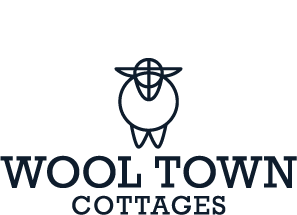Suffolk’s wool towns: history on our doorstep
Stay in our tranquil accommodation, and you’ll enjoy a remarkable location surrounded by natural beauty and history. Hadleigh is one of five Suffolk wool towns that benefited enormously from the prosperous 15th-Century wool trade. As a result, once-quiet villages emerged as bustling centres of commerce, with lavish merchants’ houses, grand churches built much larger than was necessary and guildhalls.
To this day, the wool towns of Hadleigh, Lavenham, Clare, Sudbury and Long Melford retain their late medieval charm. Quirky, wonky, timber-framed houses seem to defy the laws of physics. In Suffolk parlance, they are “sloightly on th’ huh”. Winding, quiet streets and market squares remain, and the charming architecture attracts an artistic, craft and café-society vibe.
The art connection goes right to the core of local history. Internationally renowned artists inspired by the area’s beauty include Sudbury’s Thomas Gainsborough. John Constable’s family lived at Flatford Mill, which inspired the Hay Wain, while Alfred Munnings moved from north Suffolk to settle in nearby Dedham on the River Stour. Artist-gardener Cedric Morris and his partner Arthur Lett-Haines, established the East Anglian School of Painting and Drawing at Benton End in Hadleigh which became the centre of a diverse community of artists, writers, and horticulturalists throughout the 1940s and 1950s.
When it comes to places to visit during your stay here, you are spoilt for choice. So, enjoy this guide to the five wool towns to help you decide where to go. Strictly speaking, they are not all “towns”, but each has a fine selection of pubs, restaurants, and tea rooms should you need refreshment between nosing around everything they have to offer.
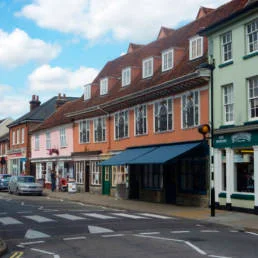
The most easterly of the five wool towns is Hadleigh, around ten miles from Suffolk’s county town of Ipswich. Situated on the River Brett, it enjoys an eclectic mix of independent retail and hospitality businesses along the high street.
Like so many towns of its kind, it has a Guildhall (actually formed of three structures) and fine listed buildings, many boasting highly detailed 17th-century plasterwork. There is also a handsome Anglican church, St Mary the Virgin.
The local artistic connections continue, as Hadleigh was the chosen home of the artist Cedric Morris, who moved his East Anglian School of Painting and Drawing there. Former students include Lucien Freud.
For the adventurous, the town has some glorious walks along the river and out into the countryside via the disused Railway Walk.
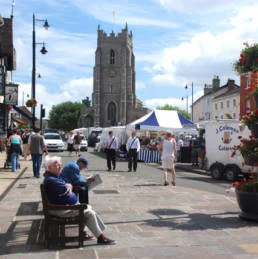
The largest of the wool towns, Sudbury had perfect transport links for that period, by road and river, and within a reasonable distance of the coast and London. It’s known as England’s Silk Capital, having moved on from woollen materials to lighter fabrics and silk. Even Gainsborough’s father was a weaver.
With a population now approaching 14,000, Sudbury sprung up initially as an Anglo-Saxon settlement in the 8th century, with a market added in the 11th century (today’s market still opens twice a week). The town is blessed to be set in the Stour Valley, an Area of Outstanding Natural Beauty.
Places to visit include Kentwell Hall, Gainsborough’s House, the Heritage Centre and Museum, and the imposing St Peter’s Church, which is now a cultural and community venue.
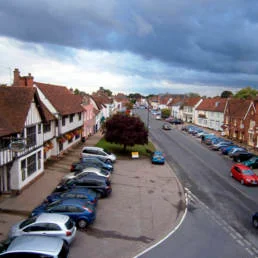
Just three miles from Sudbury is the quaint village of Long Melford. Prehistoric finds suggest the area was settled as long ago as 8300BC. The Romans constructed two roads through the area more recently, while Saxon and Bronze Age artefacts have also been uncovered.
Today, the village retains the beauty and opulence that it must have exuded during the height of the wool trade when, in 1446, 30 weavers were named as living and working there. One hundred village buildings are listed.
Visitors today admire the Holy Trinity church, one of the richest in the region noted for its decorative flint and stone masonry. Like Kentwell Hall, Melford Hall was visited by Elizabeth 1, and much of the area’s history is recounted in the Long Melford Heritage Centre.
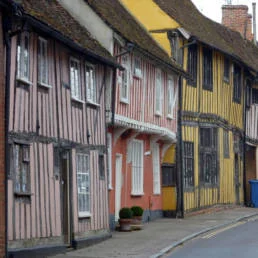
Crooked houses with intricate detailing abound in this glorious, time-warp village, noted for its Guildhall and large 15th-century St Peter and St Paul church. Film fans might recognise the market square from the 1968 Vincent Price movie, the Witchfinder General. Thankfully, no witches are burnt in front of the Guildhall these days.
Instead, you can saunter along the main street and enjoy art galleries, independent shops, tea rooms and inns, including the well-known The Swan. Visit the Guildhall and the Little Hall Museum. If you’re visiting in November, you might be in time to experience the Lavenham Literary Festival.
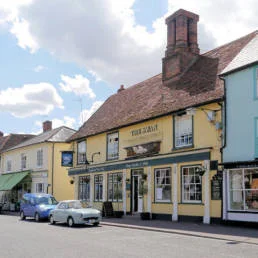
You wouldn’t think a community of just 2,000 residents could have so much on their doorstep. Yet Clare, another of the five members of Suffolk’s Wool Towns Association, has seemingly everything. History and culture abound in this beautiful, picture-postcard village nestled in the Upper Stour Valley.
There are 130 listed buildings, many housing the towns dizzying array of independent stores, cafes and pubs. St Peter and St Paul Church – like its namesake in Lavenham, dominates the skyline, while The Ancient House Museum, parts of which date back to the 14th-century, provides a fascinating insight into life in the village in years gone by.
Clare is a ‘Walkers are Welcome Town’ because everything is within reach on foot. Explore the 36-acre Country Park, with its Clare Castle remains, Clare Priory and even the village’s own nine-hole golf course.
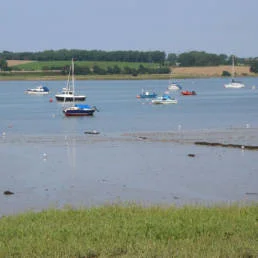
We’ve added Manningtree, although it’s actually just over the county border in Essex. Having traditionally claimed to be the smallest town in England (population 700 in 2007), the town got rich from the wool trade, with its port access to the sea. Shipping corn, timber and coal added to the town funds before the railways came along.
Visit the Wrabness Nature Reserve, or the Mistley Towers, which is all that remains of the Church of St Mary the Virgin. If the weather is bad, drop into the North House Gallery, which has a large collection and regularly stages exhibitions.
Enjoy a friendly welcome
Wherever you choose to visit from your base with us, you’ll be certain of a friendly welcome. Suffolk locals are proud of their heritage and are happy to share their knowledge with you. And once you’re done for the day, you know you can come back here to savour a good night’s rest.
Why stay with Wool Town Cottages?
• We pride ourselves on comfort, style and service
• Delightful accommodation in perfect locations
• All service costs included
• Flat-screen TVs and free Wi-Fi
• High-quality bed linen and towels
• Welcome hamper with local produce
• Vast local knowledge and recommendations for your stay
